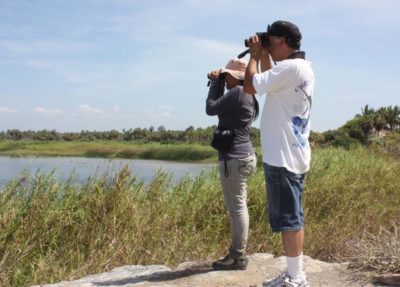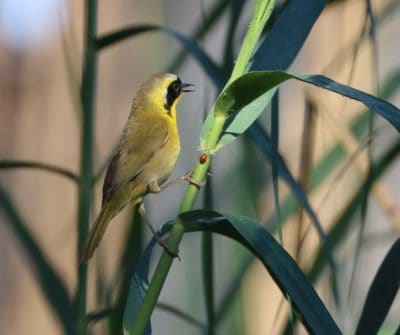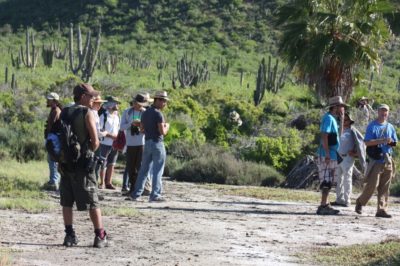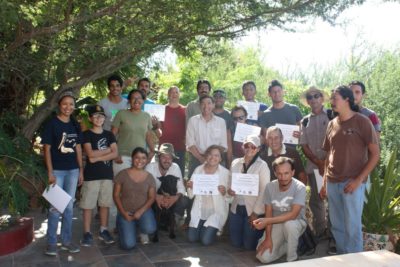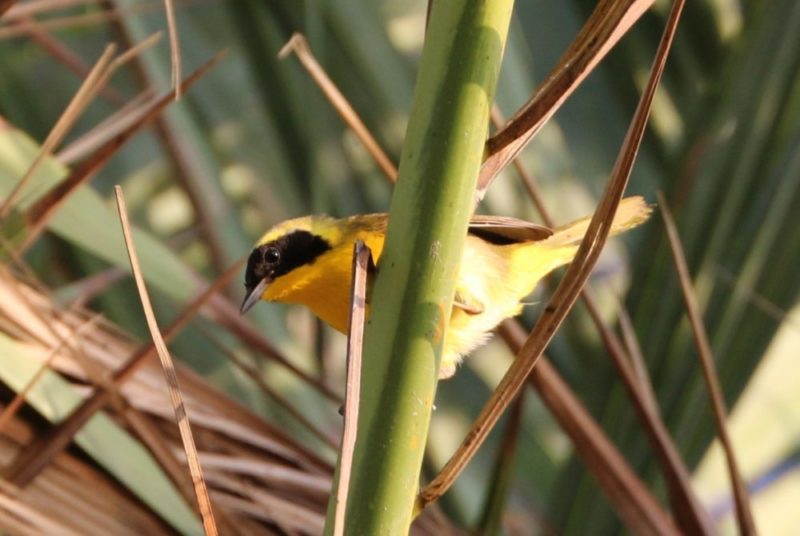
While much of the lowlands of the Baja California peninsula in Mexico are characterized by desert landscape and dry climate, the region is also dotted with permanent freshwater bodies known as oases. For local fauna, these oases offer important resources including food, shelter, and fresh water. The Belding’s Yellowthroat (Geothlypis beldingi) is an endemic species found only in Baja California Sur. It has an estimated global population of just 1,500 to 4,000 individuals. The species faces serious threats due to loss of habitat, including overexploitation of aquifers, fires, unsustainable grazing, disturbance, and poorly planned coastal development. Part of the challenge for Belding’s Yellowthroat is that it has very specific habitat requirements. It only resides in the reeds and cattails of the marsh vegetation surrounding these few peninsular oases. Very little information is known about the species. For these reasons, the Belding’s Yellowthroat is classified as endangered by the Mexican Government and by the International Union for Conservation of Nature.
Funded by the SJV Awards Program, Dr. Roberto Carmona of the University of Baja California Sur, in collaboration with Dr. Miguel Cruz, Gustavo D. Danemann, Adriana Hernández Alvarez, Gerardo Marrón, and Abigail Rivas Orilla of Pronatura Noroeste, developed a project to contribute to Belding’s Yellowthroat conservation in two oases in Baja California Sur. The three major objectives of the project were:
- To determine the abundance of Belding’s Yellowthroat in the oases of Todos Santos, B. C. S., Mexico
- Disseminate the importance of these oases for the conservation of the Belding’s Yellowthroat
- Submit a critical habitat proposal to the Directorate General of Wildlife for the Mexican government to designate these oases as protected areas
During 2014 and 2015 with the support of the SJV, the researchers implemented a monitoring program to determine the minimum abundance of Belding’s Yellowthroat. Between April 2014 and December 2015, they had 1,755 records of Belding’s Yellowthroat in both oases combined. They identified approximately 154 individuals between the two sites. Because they observed young birds during May and June, they were also able to confirm breeding at both oases.
The main threat to the ecological integrity of an oasis is the interruption or diversion of the freshwater stream that feeds it. While the system fluctuates annually due to the amount of rainfall, without adequate freshwater, the lagoon becomes hypersaline. This can cause plants, aquatic insects, and even fish to die. Aquatic insects are the main food source of Belding’s Yellowthroat, so that directly affects their survival. For example, in 2015, researchers did not detect any reproductive success at one of the oases, most likely due to lack of food resources. To ensure the survival of this endangered species, it is imperative to protect the integrity of these remaining critical habitats.
Because human activity is the biggest threat to these oases, researchers carried out a series of outreach activities within the local community and for government agencies. They gave presentations to elementary school students to teach basic information about the oases, their importance to the community, the animals living in them, and their relevance to the Belding’s Yellowthroat. Researchers gave recommendations to the local government to support the conservation of this species with the goal of transmitting good practices for its conservation. Because Belding’s Yellowthroat is an endemic species, many birders travel to the region in hopes of seeing it. In an effort to direct this interest in support of conservation, the researchers offered a bird identification course for regional ecotourism guides and the public. It included basic aspects of bird observation and identification, as well as the importance of citizen participation in knowledge generation for science and conservation.
Researchers are currently working on the final step in the process: submit a proposal to the Mexican government to designate the two oases as protected areas, and give long-term protection to these important sites and the species that rely upon them.
To learn how you can see Belding’s Yellowthroat in the SJV region, visit the Mexico Birding Trail.
To learn more about these efforts, contact Dr. Roberto Carmona.
All photos courtesy of Pronatura Noroeste A.C. and Universidad Autónoma de B.C.S. Laboratorio de Aves


 English
English  Español
Español 